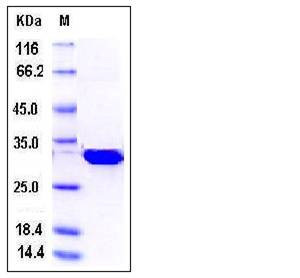Mouse LXN / Latexin Protein (His Tag)
MGC144352, MGC144353
- 100ug (NPP3386) Please inquiry
| Catalog Number | P50050-M07E |
|---|---|
| Organism Species | Mouse |
| Host | E. coli |
| Synonyms | MGC144352, MGC144353 |
| Molecular Weight | The recombinant mouse LXN consisting of 228 amino acids and has a calculated molecular mass of 26.3 kDa. The apparent molecular mass of the rmLXN is approximately 32 kDa in SDS-PAGE under reducing conditions. |
| predicted N | Met |
| SDS-PAGE |  |
| Purity | > 95 % as determined by SDS-PAGE |
| Protein Construction | A DNA sequence encoding the mouse LXN (NP_058033.2) (Glu 2-Glu 222) was expressed, with a polyhistide tag at the N-terminus. |
| Bio-activity | Measured by its ability to inhibit carboxypeptidase-A1 cleavage of the colorimetric peptide substrate Ac-Phe-Thiaphe-OH in the presence of 5,5'Dithiobis(2-nitrobenzoic acid) (DTNB) (Edwards, K.M. et al, 1999, J. Biol. Chem. 274:30468) . The IC50 value is <2.0 nM . |
| Research Area | Immunology |Inflammation / Inflammatory Mediator |Cells Involved in Inflammation |Monocyte/Macrophage |
| Formulation | Lyophilized from sterile PBS, pH 8.0, 10% glycerol 1. Normally 5 % - 8 % trehalose, mannitol and 0.01% Tween80 are added as protectants before lyophilization. Specific concentrations are included in the hardcopy of COA. |
| Background | Mouse Latexin, also known as endogenous carboxypeptidase inhibitor, tissue carboxypeptidase inhibitor, TCI, ECI and LXN, is a cytoplasm protein which belongs to the protease inhibitor I47 (latexin) family. It is highly expressed in heart, prostate, ovary, kidney, pancreas, and colon. Latexin / LXN is the only known endogenous specific inhibitor of zinc-dependent metallocarboxypeptidases (MCPs) present in mammalians so far. Latexin is originally identified as a molecular marker for the regional specification of the neocortex in development in rats. The 222 amino acid latexin in human shows different expression distribution with high levels in heart, prostate, ovary, kidney, pancreas, and colon, but only moderate or low levels in other tissues including brain. Latexin is also expressed at high levels and is inducible in macrophages in concert with other protease inhibitors and potential protease targets, and thus is suggested to play a role in inflammation and innate immunity pathways. Despite of the non-detectable sequence similarity with plant and parasite inhibitors, Latexin is related to a human putative tumor suppressor protein, TIG1. In addition, Latexin is also implicated in Alzheimer's disease. |
| Reference |
